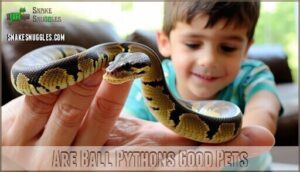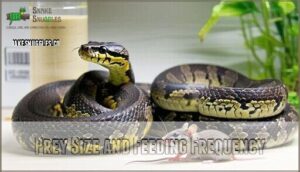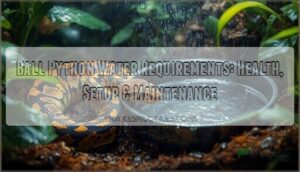This site is supported by our readers. We may earn a commission, at no cost to you, if you purchase through links.

You’ll need to provide proper heating, humidity, and feeding frozen rodents every 1-2 weeks. They live 20-30 years, so you’re making a serious commitment.
Setup costs run $300-500, with ongoing expenses around $200 yearly. They’re perfect if you want a low-maintenance companion that won’t wake the neighbors.
However, they’re not cuddly, and some people find feeding them whole prey unsettling. Your housing situation and local laws matter too, since some areas restrict snake ownership.
The key factors that determine whether they’re right for you involve more than just their calm temperament.
Table Of Contents
- Key Takeaways
- Ball Pythons as Pets
- Are Ball Pythons Good Pets
- Ball Python Housing Needs
- Ball Python Diet and Feeding
- Ball Python Care and Maintenance
- Ball Python Health and Wellness
- Ball Python Handling and Ownership
- Choosing The Right Ball Python
- Frequently Asked Questions (FAQs)
- Do ball pythons like to be petted?
- Do ball pythons like to be cuddled?
- Do ball pythons like being handled?
- Is a ball python a good beginner snake?
- Can ball pythons bite their owners?
- Do ball pythons need special veterinary care?
- How much do ball pythons cost initially?
- Can ball pythons live with other pets?
- Do ball pythons require permits or licenses?
- Conclusion
Key Takeaways
- You’ll find ball pythons are docile pets that rarely bite and don’t need daily interaction.
- You must provide proper heating, humidity, and feed frozen rodents every 1-2 weeks, committing to care for 20-30 years.
- You’ll spend $300-500 upfront on setup, with ongoing yearly costs around $200, so plan your budget before buying.
- You need to check local laws, as some areas restrict snake ownership, and be comfortable with their unique feeding and handling needs.
Ball Pythons as Pets
You’re probably curious about ball pythons because they’ve become one of the most popular pet reptiles worldwide.
These gentle snakes, scientifically known as Python regius, get their name from their defensive habit of curling into a tight ball when they feel threatened.
Scientific Name and Common Name
The scientific name Python regius identifies this popular snake species, while "ball python" describes their defensive behavior of curling into a tight ball when threatened.
- Python regius serves as the official scientific classification for this African python species
- Ball python comes from their signature defensive posture of forming a protective ball
- Royal pythons is an alternative common name used in some regions and publications
- Name origins trace back to their natural habitat in West and Central Africa
- Scientific classification places them in the Python genus alongside other constrictor species
General Characteristics and Behavior
Ball pythons earn their name from their unique defensive strategy of curling into a tight ball when threatened.
When scared, these gentle snakes curl up tightly, forming a perfect ball to protect themselves.
These docile snakes possess a naturally calm temperament, making them ideal for safe handling.
Their nocturnal habits and solitary nature mean they’re content spending most of their time quietly resting in their enclosure, rarely showing aggression toward their owners, which is a key aspect of their defensive strategy.
Size and Lifespan
When you choose a ball python pet, expect a manageable size—adults reach 3-5 feet, with females larger than males.
The growth rate is about a foot per year for the first three years, and gender differences matter for snake size.
In captivity, the snake lifespan is 20-30 years, sometimes longer, with the record age being a whopping 63 years.
The wild lifespan is much shorter.
Are Ball Pythons Good Pets
If you’re looking for a beginner snake, a ball python pet might fit the bill.
Their docile nature and low maintenance needs make them stand out among beginner reptiles.
Many owners find these snakes easy to care for, especially since they don’t need daily feeding or constant attention.
Space requirements are modest—adults do well in a moderate-sized enclosure, so they’re suitable for apartments or small homes.
Because of their gentle temperament, ball pythons are often considered kid-friendly pets, though supervision is always wise.
While python pet ownership doesn’t offer the same interaction as a dog or cat, these snakes are calm and rarely aggressive.
Their popularity is also boosted by the availability of unique ball python morphs.
If you want a peaceful, manageable snake pet, ball pythons are a solid choice for most households.
Ball Python Housing Needs
Creating the right home for your ball python is essential for their health and happiness.
You’ll need to set up an enclosure with proper temperature gradients, humidity levels, and adequate space for your snake to thrive.
Enclosure Size and Type
A proper snake enclosure starts with the right tank dimensions—think 40-gallon terrarium for adults and 10-20 gallons for hatchlings.
Use sturdy enclosure materials like glass or plastic with a secure lid, since ball pythons are escape artists.
Good space utilization means adding enrichment items and hides. Meeting cage requirements guarantees your habitat setup supports healthy, stress-free living.
Proper heating is essential, so consider using a thermostat-regulated heat pad, which is crucial for a stress-free environment and ensures healthy living with proper heating.
Substrate Options and Temperature
Creating the right foundation sets your ball python up for success.
Substrate types like coconut husk, cypress mulch, or paper towels work well. Your snake needs a temperature gradient with the warm side at 88-92°F and cool side at 78-80°F.
A good choice will provide excellent moisture retention for your ball python.
- Paper towels: Easy cleanup, good for beginners
- Coconut husk: Holds humidity, reduces odors naturally
- Cypress mulch: Natural look, maintains moisture levels
- Avoid cedar/pine: Oils can irritate your snake’s skin
Humidity Levels and Lighting
Maintain humidity between 50-60% to prevent shedding issues.
Use hygrometers to monitor levels and thermometers for temperature gradient control. UV light isn’t essential but helps regulate day-night cycles.
Many owners find a reliable humidity reader essential for proper care.
| Humidity Requirements | Lighting Setup |
|---|---|
| 50-60% humidity levels | Optional UV light cycles |
| Monitor with hygrometers | Timer-controlled automation |
| Proper enclosure placement | Natural day-night rhythm |
Ball Python Diet and Feeding
Feeding your ball python correctly is essential for their health and wellbeing. You’ll need to provide pre-killed rodents at the right intervals and watch for potential feeding-related health problems.
Prey Size and Feeding Frequency
Ball python feeding follows a simple schedule based on age.
Juveniles need frozen mice or small rats every 5-7 days, while adults eat every 1-2 weeks.
Rodent size should match 10-15% of your snake’s body weight.
Young pythons start with hoppers, progressing to adult mice as they grow.
Overfeeding risks obesity and health problems.
Feeding Process and Nutrition
Getting snake meal timing right means understanding your ball python’s natural rhythm and nutritional needs.
Start by offering frozen thawed rodents like frozen mice or rats sized appropriately for your snake. Your feeding schedule should match your python’s age and size requirements.
- Frozen rodents eliminate parasites – giving you peace of mind about your pet’s health
- Consistent prey type builds trust – your snake learns what to expect at mealtime
- Proper nutritional needs prevent obesity risks – keeping your companion healthy for decades
- Ball python feeding becomes routine – creating a bond through reliable care
Common Health Issues and Prevention
After feeding, it’s smart to watch for signs of snake health problems like Mouth Rot, respiratory infections, or mites.
Keep humidity steady and bedding clean to avoid respiratory ailments and bacterial infections.
Quarantine protocols for new snakes and regular vet checks help stop snake diseases.
Mite prevention starts with clean gear and good hygiene, and it’s also important to find a snake vet for any ongoing issues, which can help prevent respiratory infections.
Ball Python Care and Maintenance
Ball pythons require minimal daily care since they spend most of their time resting in their enclosure.
You’ll need to perform monthly deep cleaning and can automate UV lighting with timers for convenience.
Daily Care and Supervision
Daily care for your ball python requires minimal effort but consistent attention.
Check the snake temperature and snake humidity levels, refresh water weekly, and do basic enclosure spot-cleaning as needed.
Monitor your pet’s behavior for signs of stress or illness.
Limited interaction works best since these snakes prefer solitude over frequent snake handling or enrichment activities.
Monthly Deep Cleaning and Hygiene
Monthly cleaning keeps your snake healthy and your home odor-free. Complete substrate replacement should happen every four weeks, along with disinfecting the entire enclosure.
Remove all waste promptly to prevent bacterial growth. Clean snake water bowls weekly with reptile-safe disinfectant.
Deep cleaning your snake enclosures involves scrubbing all surfaces, replacing substrate completely, and sanitizing decorations. You can find a suitable enclosure cleaner online.
This cleaning frequency maintains proper snake hygiene and prevents ammonia buildup that can harm your pet.
UV Lighting and Automation
Once your reptile enclosure is spotless, focus on UVB benefits and lighting schedules.
Ball pythons don’t need UVB to survive, but it helps with vitamin D3 and overall health impact.
Use basking bulbs and automation systems, like timers and WiFi sensors, to keep conditions steady.
These tools make pet care and pet ownership much smoother, especially for busy owners who value automation systems.
Ball Python Health and Wellness
Keeping your ball python healthy requires knowing what to watch for and having a good reptile vet on standby.
You’ll need to spot early warning signs and understand when professional care is necessary to keep your snake thriving for decades.
Common Illnesses and Symptoms
After keeping up with regular care, it’s smart to watch for signs of snake illnesses.
Mouth Rot, Blister Disease, and Respiratory Infections can show as mouth swelling, blisters, or noisy breathing.
Mites, Ticks, and Inclusion Disease also threaten snake health.
Snake health indicators include clear eyes, steady weight, and smooth breathing—notice any changes, and act quickly to address potential issues like Respiratory Infections.
Treatment and Veterinary Care
When your ball python shows signs of illness, you’ll need a qualified reptile vet who understands snake health.
Exotic vet access can be limited, so locate one before emergencies arise.
Emergency treatment for snake illnesses often requires antibiotics or specialized care.
Veterinary bills stay reasonable since visits are infrequent, and professional snake veterinarians provide the best outcomes for serious conditions requiring immediate intervention.
Quarantine and Prevention
Introducing a new snake to your home requires careful new snake isolation to protect your existing pets and prevent disease transmission.
Always quarantine new arrivals for 3-6 months in a separate room with dedicated equipment. During this period, schedule vet checkups for disease screening and parasite prevention.
Watch for snake parasites like snake mites and ticks, which appear as small moving dots or bumps. Follow strict hygiene protocols by washing hands and changing clothes between handling different snakes to prevent snake disease prevention issues.
Ball Python Handling and Ownership
Proper handling guarantees your ball python stays calm and reduces stress for both of you. Understanding legal requirements, costs, and long-term commitment helps you make an informed decision about ownership.
Handling Techniques and Safety
Proper python handling keeps you and your snake safe. Wait 24 hours after feeding to prevent regurgitation. Support the snake’s body fully when lifting.
- Safe Handling: Move slowly and support the snake’s weight with both hands.
- Avoiding Bites: Never grab from behind or handle during shedding periods.
- Children Handling: Supervise kids closely and teach proper snake handling techniques.
- Shedding Sensitivity: Avoid handling when eyes appear milky or skin looks dull.
- Handling Frequency: Limit sessions to reduce stress and maintain snake handling precautions.
Legal Restrictions and Regulations
Before buying a ball python, check your local ordinances and state regulations.
Some cities ban all pythons, while others require exotic pet permits.
Federal laws under CITES regulate international trade.
Research legal restrictions in your area thoroughly.
Contact local snake pet stores for guidance on compliance and ownership requirements.
Financial Commitment and Responsibility
Owning a ball python requires careful budget planning beyond the initial setup costs.
You’ll spend $200-500 upfront on equipment, then face ongoing costs for frozen rodents, substrate, and utilities.
Fortunately, affordable feeding means low monthly expenses, and these snakes have remarkably low veterinary bills.
Long-term planning guarantees your pet snake cost remains manageable throughout their 20-30 year lifespan.
Supporting breeders who prioritize ball python ethical sourcing can also influence long-term health and reduce unexpected costs.
Choosing The Right Ball Python
Deciding on a ball python requires honest evaluation of your commitment to 20-30 years of care and feeding frozen rodents every week or two.
Research local laws, veterinary access, and setup costs before bringing home this long-term companion.
Research and Preparation
Before bringing home your ball python, thorough snake research is your foundation.
Species understanding helps you grasp their specific needs and behaviors.
Calculate initial costs for enclosure setup, heating, and supplies—often $300-500.
Consider long term expenses like food and veterinary care.
Verify ethical sourcing from reputable breeders.
Assess your owner lifestyle honestly: can you commit to 20-30 years of snake commitment and pet preparation responsibilities?
Suitable for Beginners and Experts
Ball pythons work great for both beginners and experienced reptile keepers.
Their docile temperament and handling ease make them perfect starter snakes. You won’t struggle with aggressive behavior since they prefer curling up over biting.
Low maintenance requirements mean you can focus on learning proper ball python care without overwhelming complexity. Even experts appreciate their calm ball python temperament and predictable needs.
Long-Term Commitment and Care
You’re committing to decades of care when you choose a ball python. These snakes live 20-30 years in captivity, creating a significant longterm commitment that spans major life changes.
The financial burden includes ongoing costs for food, heating, and veterinary care. Space requirements remain constant throughout their lifespan.
Owner responsibility means maintaining proper conditions for snake lifespan considerations while understanding pet longevity implications. These snakes require a temperature gradient maintained for ideal health.
Frequently Asked Questions (FAQs)
Do ball pythons like to be petted?
You might notice your ball python doesn’t crave petting like a dog or cat.
They tolerate gentle handling but don’t seek out affection.
Keep touches calm and brief, supporting their body, to help them feel secure.
Do ball pythons like to be cuddled?
Unlike medieval knights who craved armor’s embrace, ball pythons don’t enjoy cuddling.
They’re solitary creatures who tolerate handling but don’t seek affection.
They’ll rest on you for warmth, not companionship—it’s practical, not emotional bonding.
Do ball pythons like being handled?
You’ll find most ball pythons tolerate gentle handling, especially if you support their body.
They don’t crave attention, but regular, calm contact helps them stay docile.
Just avoid handling right after feeding or during shedding, as this can be stressful for the ball pythons.
Is a ball python a good beginner snake?
Yes, ball pythons are excellent beginner snakes.
They’re docile, rarely bite, require minimal daily care, and tolerate handling mistakes well.
Their straightforward housing and feeding needs make them perfect starter pets.
Can ball pythons bite their owners?
Ball pythons can bite owners, though it’s uncommon.
When Sarah reached into her snake’s enclosure during feeding time, her normally docile python mistook her hand for prey and delivered a quick, harmless bite.
These gentle snakes rarely bite unless stressed or threatened, and are generally considered to be gentle.
Do ball pythons need special veterinary care?
Ball pythons require reptile-experienced veterinarians for checkups and health issues. Regular vet visits aren’t needed unless illness occurs, but finding qualified exotic vets can be challenging in some areas.
How much do ball pythons cost initially?
Think of the initial cost as dipping your toes in a pond—expect to spend $100–$400 for the snake, plus $200–$500 for the enclosure, heating, and supplies. Your total startup runs about $300–$
Can ball pythons live with other pets?
Ball pythons shouldn’t live with other pets. They’re solitary animals that stress easily around other species. Keep them in separate, secure enclosures to prevent accidents and guarantee their wellbeing.
Do ball pythons require permits or licenses?
Legal requirements vary by location, but most US states don’t require permits for ball pythons.
However, some cities and counties ban or restrict snake ownership.
You’ll need to check your local laws before getting one, as regulations can change unexpectedly.
Conclusion
Looking through the lens of reptilian companionship, the question "are ball pythons good pets" isn’t simply answered with yes or no.
These serpentine friends offer unique rewards for dedicated owners who understand their specific needs. Ball pythons make excellent pets for people seeking low-maintenance companions with fascinating behaviors.
They don’t require daily interaction, live for decades, and rarely show aggression. However, success depends on providing proper heating, humidity, and accepting their feeding requirements.
Consider your housing situation, local regulations, and long-term commitment before deciding if these remarkable snakes suit your lifestyle, and ensure you can provide the necessary care for a pet that can live for decades.
- http://www.reptilesmagazine.com/Care-Sheets/Snakes/Ball-Python/
- http://www.reptileknowledge.com/news/can-a-ball-python-kill-a-human/
- https://www.britannica.com/animal/python-snake-group
- https://critterspetshop.com/snakes-why-ball-pythons-make-great-starter-pets/
- https://bobclark.com/blogs/articles/are-ball-pythons-good-pets
















